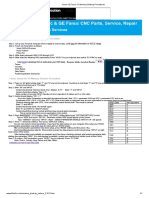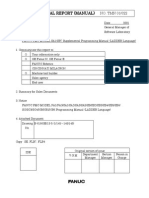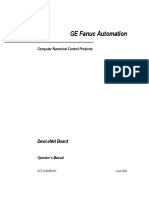Troubleshooting Manual For I/O Link Communication Alarm: (System Alarm PC050/PC150/971)
Troubleshooting Manual For I/O Link Communication Alarm: (System Alarm PC050/PC150/971)
Uploaded by
Carlos Aguilar MontemayorCopyright:
Available Formats
Troubleshooting Manual For I/O Link Communication Alarm: (System Alarm PC050/PC150/971)
Troubleshooting Manual For I/O Link Communication Alarm: (System Alarm PC050/PC150/971)
Uploaded by
Carlos Aguilar MontemayorOriginal Description:
Original Title
Copyright
Available Formats
Share this document
Did you find this document useful?
Is this content inappropriate?
Copyright:
Available Formats
Troubleshooting Manual For I/O Link Communication Alarm: (System Alarm PC050/PC150/971)
Troubleshooting Manual For I/O Link Communication Alarm: (System Alarm PC050/PC150/971)
Uploaded by
Carlos Aguilar MontemayorCopyright:
Available Formats
Troubleshooting manual for
I/O Link communication alarm
(System Alarm PC050/PC150/971)
TITLE
Troubleshooting manual for
I/O Link communication alarm
DRAW.NO.
01 01.09.14 Mochizuki New registration A78598
EDIT DATE DESIG. DESCRIPTION 1/22
1 Preface
I/O Link communication alarm is sometimes reported from MTBs and End-users, and generally, it can
take much time to solve the trouble.
In this manual, we are analyzing actual examples, and conclude how to troubleshoot these troubles.
This manual is for Service people to learn about this alarm, and to solve these troubles quickly.
TITLE
Troubleshooting manual for
I/O Link communication alarm
DRAW.NO.
01 01.09.14 Mochizuki New registration A78598
EDIT DATE DESIG. DESCRIPTION 2/22
1 Alarm Message
When I/O Link communication fails, System Alarm is issued with one of the following messages.
The message changes according to the series and edition of PMC Management Software, however, its
meaning and the process of troubleshooting are common.
PC050 IOLINK CH1 a1b1-x1y1:x2y2
PC050 IOLINK CH2 x1y1:a2b2-x2y2
PC050 I/O LINK(CHn) x1:y1 x2:y2
PC050 NMI SLC(CHn) x1:y1 x2:y2
PC050 NMI SLC x1:y1
PC150 NMI SLC x1:y1
971 NMI OCCURRED IN SLC (note)
SLC ERROR x1(y1) : PC050
SLC ERROR x1 : PC050
(note) This message has the register value “x1y1” in memory dump. Refer Chapter 1.2
„Register value in “971 NMI OCCURRED IN SLC”‟ for detail.
In these messages, “CHn” (n ≥ 1) means the channel of communication failure. The messages
without “CHn” means the error was detected in channel 1.
The portion “a1b1”, “x1y1”, “a2b2” and “x2y2” are the register values of SLC, which is I/O Link
communication controller LSI. The value “a1b1” and “x1y1” are of channel 1; “a2b2” and “x2y2” are of
channel 2. The register value of channel 2 will always be displayed at PMC software that supports “I/O
Link expansion” option, whether the option is purchased or not.
Some messages have “a1b1” and “a2b2”, which are earlier value than “x1y1” and “x2y2”.
earlier later
Channel 1 a1b1 x1y1
Channel 2 a2b2 x2y2
TITLE
Troubleshooting manual for
I/O Link communication alarm
DRAW.NO.
01 01.09.14 Mochizuki New registration A78598
EDIT DATE DESIG. DESCRIPTION 3/22
The register values are clues certainly, however, they may not be enough evidence to find out the cause
of troubles because of following reasons:
These values are not the values at the instant when the first communication error was detected,
but are the values when the communication disconnected finally. This means that the values may
not reflect the direct cause, and can reflect its side effect.
In case of hardware malfunction or electric noises, the register value may become improper value.
The same causes may show different register value depending on the timing of error.
Therefore, it is important to analyze not only register value, but also the situation how the alarm
occurred.
Note
The versions of PMC model in following table may misidentify I/O Link communication
alarm and may issue the message below:
PC081 FLEMG xxxxxxxx:yyyyyyyy
PMC
CNC Model may
PMC Model series corrected
misidentify
FS16i/18i/21i-A PMC-SA5/SB5/SB6 406A 01~12 13~
Power Mate i-D/H PMC-SB5/SB6 407B 01~03 04~
FS15i PMC-NB6 404A 01~04 05~
TITLE
Troubleshooting manual for
I/O Link communication alarm
DRAW.NO.
01 01.09.14 Mochizuki New registration A78598
EDIT DATE DESIG. DESCRIPTION 4/22
1.1 SLC’s register value
1.1.1 Detail of a1, a2, x1 and x2
xn#7 xn#6 xn#5 xn#4 xn#3 xn#2 xn#1 xn#0
xn#0 Bad data was received: If xn#1 is 1, xn#0 will always be 1. So check xn#1 first.
xn#1 Slave device detected an error. See yn for more detail.
xn#2 Slave did not respond. Link was disconnected.
xn#3 SLC, I/O Link controller LSI, detected parity error of internal RAM. Exchange PMC
control module, or the board with I/O Link connector.
xn#4 Parity error in I/O RAM was detected. Exchange PMC control module, or the board
with I/O Link connector.
xn#5~7 meaningless
1.1.2 Detail of b1, b2, y1 and y2
yn#7 yn#6 yn#5 yn#4 yn#3 yn#2 yn#1 yn#0
When slave detected communication error (in case xn#1 is 1), this value shows the slave
number and the detail of the error.
Otherwise (in case xn#1 is 0), this byte will be the slave number of which master
communicated last, or of which master was trying to communicate. But this slave number
does not mean the very slave with problem. For example, in case that connection between 1 st
slave and 2nd slave was cut when master was trying to communicate with 3rd slave, this byte will
show the number for 3rd slave.
yn#0~4 Number to identify slave: the value is “<group number> + 1”, where the 1st slave is
group 0. For example, the value 4 means the group 3, which is 4th slave from master.
yn#5 Slave detected communication error. (not effective if xn#1 is 0)
yn#6 Slave raised System Alarm other than one about I/O Link. Check what System
Alarm was raised at slave. (not effective if xn#1 is 0)
yn#7 Slave detected watchdog error or parity error. (not effective if xn#1 is 0)
TITLE
Troubleshooting manual for
I/O Link communication alarm
DRAW.NO.
01 01.09.14 Mochizuki New registration A78598
EDIT DATE DESIG. DESCRIPTION 5/22
1.2 Register value in “971 NMI OCCURRED IN SLC”
In some CNC and PMC model, the following screen is displayed at I/O Link communication failure.
In this screen, the SLC‟s register value is not shown in the error message itself, however, you can pick up
the value from following dump display.
1.2.1 Dump with register names
・ Models
CNC models PMC models
Series 21i-A/B PMC-SA1
Series 16-B PMC-SB3/SB4
Series 18-B PMC-SA1/SA3
Series 21-MB PMC-SA1/SA3
Series 21-TB (B type) PMC-SA1/SA3
・ Position of SLC’s register (bold and underlined)
SYSTEM ALARM
971 NMI OCCURD IN SLC
EAX EBX ECX EDX ESI EDI EBP ESP
00008401 00008400 00000000 00000000 00001228 00000528 00000A2C 0000FFE6
SS DS ES FS GS TR LDTR EFLAGS VECT ERRC ERROR-ADDRESS
0040 0050 00D0 00B0 0050 0648 0028 00003006 FFFF 0070:00000530
STACK(PL0)
7206 04D0 0050 0050 100A 0098 4741 0038 1209 0000
NMIC 01001000 00000000 00000000 11010001
TITLE
Troubleshooting manual for
I/O Link communication alarm
DRAW.NO.
01 01.09.14 Mochizuki New registration A78598
EDIT DATE DESIG. DESCRIPTION 6/22
1.2.2 Dump without register names
・ Models
CNC models PMC models
Series 16-A PMC-SB/SB2/SB3
Series 18-A PMC-SA1/SA3
Series 21-TB (A type) PMC-SA1/SA3
Power Mate-D PMC-PA1/PA3
Power Mate-H PMC-PA3
・ Position of SLC’s register (bold and underlined)
SYSTEM ALARM B005-25
971 NMI OCCURRED IN SLC
0050 00A0 00D0 0050 0040 0401 8401 0000
0000 0E40 0140 0E9F FFE6 FFFF 056B 0068
7282 0510 0050 0050 0001 0088 40F1 0038
177C 0000
NMIC 01001000 00000000 10000000 11111001
TITLE
Troubleshooting manual for
I/O Link communication alarm
DRAW.NO.
01 01.09.14 Mochizuki New registration A78598
EDIT DATE DESIG. DESCRIPTION 7/22
2 Cause of communication failure
I/O Link communication failure can be caused by various causes such as followings:
(a) Wrong communication cable, disconnection, unstable connection
The electric cables used for I/O Link connection can be distinguished into the types below.
Check cables are properly used. Check wiring of cables with “CONNECTING MANUAL”.
Wiring of twisted-pair needs special care: SIN must be paired with *SIN, and SOUT with
*SOUT. If wrong signals are paired, the cable may easily affected by electric noises. Do not
wire unused terminal: There are power lines such as +24V and +5V, and unintended wiring of these
lines may cause malfunction of devices.
K1X : connects groups.
K2X : connects bases.
K3X : connects Optical I/O Link Adapter or I/O Link Dummy Unit.
(no name?) : connects I/O Link Signal Divider.
(b) Wrong connector
I/O Link connection between groups starts from “JD1A” and ends to “JD1B”. Check the
connector‟s name.
(c) Loose connection
Check all connectors are firmly plugged. Just plugging again sometimes solves troubles.
(d) I/O assignment data mismatch
Mismatch between I/O assignment data and actual I/O device configuration may cause
communication failure. For example, combination of assignment data with “base expansion” and
actual I/O configuration without expanded base will cause System Alarm at start.
TITLE
Troubleshooting manual for
I/O Link communication alarm
DRAW.NO.
01 01.09.14 Mochizuki New registration A78598
EDIT DATE DESIG. DESCRIPTION 8/22
(e) Electric noises
Refer “CONNECTING MANUAL (Hardware)”, and take measures to avoid influence of noises.
If communication cable and power cable are tied together, noises from power cable may affect
communication. They should be tied separately. Shield of a communication cable must be
grounded via cable clamp. (See “CONNECTING MANUAL (Hardware)”)
(f) Short circuit of DO
With some model of I/O module for operator's panel, short circuit of DO with ground or other DO
by wrong wiring or malfunction of some device, may cause communication failure.
(g) Insufficient power supply or low voltage
Check the capacity of power supply. Even if the power supply had enough capacity at first
design, later modification may need more capacity. In some cases, we had no trouble at power
supply capacity in usual operation, but specific operation caused low voltage.
(h) Insufficient connection to power supply
Check the power cable. We had several cases that the loose connection with power supply unit
disturbed stable power supply, and caused System Alarm that occurred rarely.
(i) Malfunction of power supply unit
Malfunction of power supply unit may cause instant power failure and then communication
failure.
(j) Restarting CNC without restarting slave I/O devices
I/O Link slave devices must be restarted when I/O Link master device (CNC) is restarted.
Specially, slaves of intelligent type such as Series 0-C, Power Mate, β amplifier, and Spindle
Monitor Unit, will raise System Alarm at power cut of master. In this situation, restarting CNC will
raise another System Alarm at CNC by bad status of slaves.
(k) System down of slave device
When I/O Link slave of intelligent type is connected, System Alarm at slave device will cause
System Alarm at master CNC. And System Alarm at master CNC vice versa. In this
TITLE
Troubleshooting manual for
I/O Link communication alarm
DRAW.NO.
01 01.09.14 Mochizuki New registration A78598
EDIT DATE DESIG. DESCRIPTION 9/22
configuration, it is important which System Alarm occurred first, and caused other System Alarm.
If slave device does not raise System Alarm while master raises, this may happen by power failure
of slave device; master CNC raised System Alarm at power failure of slave device, and then the
slave device restarted.
(l) Unstable grounding of Optical I/O Link Adapter
I/O Link Adapter, which connects electric cable and optical cable, must be grounded to earth via
its casing.
(m) Malfunction of CNC or I/O devices
Malfunction of hardware is also possible. Try to change the board with I/O Link connector such
as Master PCB or PMC Board, PMC Control Module (not detachable in some PMC model), Back
Panel, each slave devices.
(n) Wrong operation
If the System Alarm occurred only once, it has possibility of wrong operation by human error
such as cutting power of slave device by mistake.
TITLE
Troubleshooting manual for
I/O Link communication alarm
DRAW.NO.
01 01.09.14 Mochizuki New registration A78598
EDIT DATE DESIG. DESCRIPTION 10/22
3 Items to check
Check the following items, judge them totally, and find the cause such as ones in previous section.
(1) How long did it work?
“Did it work normally before?”
If a machine that worked without problem suddenly started raising alarm, modification of the
machine or related facilities may be the cause; the modification may generate electric noise,
insufficient connection, short of power supply capacity. Malfunction of some device can also be
the cause.
On the other hand, at trouble on a machine in assembling, you have to start with I/O Link
assignment data and hardware connection.
(2) Device configuration and I/O Link assignment
“What configuration?”
Check the actual I/O Link configuration and assignment data; what kind of slave devices, how
they are connected with master.
And check whether the contents of I/O Link assignment data match the actual configuration,
whether the number of I/O signals does not exceed the specification of I/O Link, whether necessary
terminator is correctly attached, and so on, referring “CONNECTING MANUAL (Hardware)”.
(3) Timing
“What was the machine doing?”
If System Alarm occurs at power-on phase, check if cables connect correct pair of connectors, and
I/O Link assignment data first. If the assignment data has entry for base expansion while the base is
not attached actually, System Alarm occurs at power-on.
When the master CNC restarts, all slave devices must also restart. Check the power for slave
devices is surely cut when the power for master CNC is cut.
If System Alarm occurs every time when some specific action is taken, the action can be the cause
of unstable connection, electric noises, short of power supply capacity, or unexpected voltage by
short circuit of DO.
TITLE
Troubleshooting manual for
I/O Link communication alarm
DRAW.NO.
01 01.09.14 Mochizuki New registration A78598
EDIT DATE DESIG. DESCRIPTION 11/22
(4) Operation
“Does same operation always lead to same result?”
In case that same operation always produces same System Alarm, you can find out the origin of
trouble by removing slave device one by one starting from the one of largest group number.
Removing slave device, however, is dangerous in some cases and should be done carefully enough,
because it may bring trouble at operating the machine; such as removing I/O device that is connected
to operator‟s panel.
If System Alarm is hard to reproduce, and occurs rarely, it will be very difficult to find out the
cause of trouble. Try every countermeasure at once, then wait and see how things turn out;
changing hardware such as master, slave and cable stuff, use power supply of more capacity, or use
another power supply additionally, enhance grounding to earth and shield of cables, tying cables of
different kind separately, and so on.
(5) Information at System Alarm
“Does System Alarm always provide the same information?”
Every time System Alarm occurs, the message of System Alarm including SLC‟s register values,
LED indicator of slave devices, and the message of System Alarm at slave if occurred, should be
noted and checked. As described in former section, these may change every time System Alarm
occurs, in some cases. If these actually change, the information from them is not so reliable.
(6) Alarm history / System Alarm history
“Is there any other alarm?”
Other alarm may occur just before System Alarm of I/O Link communication, and may cause the
System Alarm. Check the Alarm history and System Alarm history.
If slave devices also have such histories, check them, too.
(7) SLC’s register value
“What information is reported from SLC?”
TITLE
Troubleshooting manual for
I/O Link communication alarm
DRAW.NO.
01 01.09.14 Mochizuki New registration A78598
EDIT DATE DESIG. DESCRIPTION 12/22
If all System Alarm messages show the same SLC‟s register value, the value can be an efficient
clue to the cause of trouble. But as described before, this value is not 100% reliable. From our
experiences, the value other than “n3:4m” is not meaningful, where n and m are any hexadecimal
numbers.
(8) Retry counter
“Is the communication stable?”
I/O Link makes an attempt to recover communication at communication error. When it fails to
recover it, it raises System Alarm.
When I/O Link retries communication, counter register below is incremented by one. This
counter register is allocated at same address regardless of PMC model.
meaning of register PMC address size
Retry Counter R9051 1 byte
By watching this counter register, you can know whether the communication is not stable, or the
communication is generally stable but sudden error may be detected.
If communication error occurs intermittently, and this counter is incremented frequently, this
counter can be an indicator to find out the cause; when you exchange some hardware, and then this
counter stops, you can conclude that the exchanged hardware is the cause.
This counter register is volatile memory. It will be cleared at every power-on.
TITLE
Troubleshooting manual for
I/O Link communication alarm
DRAW.NO.
01 01.09.14 Mochizuki New registration A78598
EDIT DATE DESIG. DESCRIPTION 13/22
4 Examples
4.1 System Alarm occurs about once a day.
<Category> Wrong communication cable, snapping of wire, loose connection
<Register> C4:01
<Configuration>
NC
Optical I/O Optical I/O
Link adapter Link adapter
Optical cable
I/O module I/O module I/O Unit-A
for operator‟s for connector
panel panel
Group 0 panel
Group 1 Group 2
<Cause> Cable with +5V power line was used between group 0 and 1.
<Explanation> “C4:01” can be read as communication error, which means that a slave suddenly
stopped responding.
The cable with +5V power line is for connection to Optical I/O Link adapter. To
connect devices other than Optical I/O Link adapter, the cable without +5V power
line must be used. (In this case, because the I/O module for operator‟s panel was
also exchanged when the cable was exchanged with correct one, the module may also
be the direct cause of this trouble.)
4.2 System Alarm occurs two or three times per day.
<Category> Wrong communication cable, snapping of wire, loose connection
<Register> C4:03, C6:62, C7:E2, C3:24, C4:01, C3:21
<Configuration>
TITLE
Troubleshooting manual for
I/O Link communication alarm
DRAW.NO.
01 01.09.14 Mochizuki New registration A78598
EDIT DATE DESIG. DESCRIPTION 14/22
Series 18i-TA
I/O module β amp. β amp. I/O module
for operator's for connector
panel panel
Group 0 Group 1 Group 2 Group 3
<Cause> The cable between group 2 and 3 had short circuit internally.
<Explanation> The register values look random, and provide no helpful information. But because
the System Alarm occurred with considerable frequency (two or three times a day),
we could find out the cause by removing slaves one by one starting from one of
largest group number.
4.3 System Alarm occurred at power-on after loading Ladder program at BOOT
screen
<Category> Wrong I/O assignment data
<Register> unknown
<Configuration>
unknown
<Cause> Expanded base was assigned in I/O assignment data while the I/O Unit-A had no
expanded base.
<Explanation> This machine was designed with optional devices connected by expanded base, and in
this case, the Ladder program with this option was loaded into the machine without
this option. The register value was not mentioned in this case, however, this cause
generally produces the register value of “n4:3m”. Therefore, if System Alarm is
raised at every power-on, and the register value matches with “n4:3m”, and the slave
number m points to a slave of I/O Unit-A, you should examine the I/O assignment
data first.
In this case, CNC can not start up. To avoid System Alarm and let CNC start up,
you can start it with I/O Link cable disconnected, or at BOOT screen, you can remove
Ladder program or load correct Ladder program. To check the I/O Link assignment
data, you need Edit function on CNC, or you need to transfer Ladder to Programmer
software such as FAPT LADDER-III.
TITLE
Troubleshooting manual for
I/O Link communication alarm
DRAW.NO.
01 01.09.14 Mochizuki New registration A78598
EDIT DATE DESIG. DESCRIPTION 15/22
4.4 System Alarm occurs at “Restart I/O Link” after storing Ladder program by
online function of FAPT LADDER-II/III.
<Category> Wrong I/O assignment data
<Register> 83:41
<Configuration>
Series 21i-A
I/O Unit-A I/O Unit-A I/O Unit-A
Group 0 Group 1 Group 2
<Cause> Group and base are confused in I/O assignment data.
correct wrong
Group Base Slot Module name Group Base Slot Module name
0 0 n Module 1 0 0 n Module 1
1 0 n Module 2 0 1 n Module 2
2 0 n Module 3 0 2 n Module 3
<Explanation> In most cases, I/O assignment data with wrong base number will prevent CNC from
starting up by System Alarm. But System Alarm may also occur at restarting I/O
Link connection after storing new Ladder program just like this case.
4.5 System Alarm sometimes occurs at action of conveyer after machining.
<Category> Electric noises
<Register> C4:01
<Configuration>
Series 15-A
I/O Unit-A Operator‟s Power Mate-D
panel
Group 0 Group 1 Group 2
TITLE
Troubleshooting manual for
I/O Link communication alarm
DRAW.NO.
01 01.09.14 Mochizuki New registration A78598
EDIT DATE DESIG. DESCRIPTION 16/22
<Cause> None of master, slaves, and cables had grounding connection to earth.
<Explanation> If the trouble occurs at specific action of some device, the action can be supposed to
bring low voltage of power supply, electric noises, insufficient connection or short
circuit.
4.6 System Alarm occurs at almost every automatic execution.
<Category> Electric noises
<Register> 84:01, C4:01
<Configuration>
Series 18-MA
I/O Unit-A Operator‟s
panel
Group 0 Group 1
<Cause> Communication cable was tied with power supply cable.
<Explanation> After tying communication cable separately from power cable, the alarm has stopped
being raised. This case is supposed to be caused by electric noises. Generally, the
cause of electric noises does not have obvious trigger to raise System Alarm. In
most cases, System Alarm is raised rarely, and very hard to find out the condition of
the alarm. If System Alarm occurs not so frequently, check connections between
devices and earth. When you find devices with no grounding, too thin grounding, or
communication cable lies near power cable, take measures against them, and wait and
see how things turn out.
4.7 System Alarm occurs at cycle start.
<Category> Short circuit of DO with ground.
<Register> 43:45
<Configuration>
TITLE
Troubleshooting manual for
I/O Link communication alarm
DRAW.NO.
01 01.09.14 Mochizuki New registration A78598
EDIT DATE DESIG. DESCRIPTION 17/22
Series 15i
I/O Unit-A Connection I/O Unit-A I/O Unit-A I/O module
unit for operator's
panel
Group 0 Group 1 Group 2 Group 3 Group 4
<Cause> Mistake in wiring in operator‟s panel made short circuit of a DO with ground.
<Explanation> The register value says an alarm is raised in the slave of group 4, which is I/O module
for operator‟s panel. At some I/O module for operator's panel, short circuit of DO
may cause System Alarm of I/O Link. So we searched for DO signal that turned on
at cycle start, checked wiring from the signal, and found out the cause of trouble.
4.8 System Alarm occurs at activation of conveyer system about once in five
times.
<Category> Short of power supply capacity, low voltage.
<Register> unknown
<Configuration>
Power Mate-D
I/O Unit-A
Group 0
<Cause> Activating conveyer system lowered voltage of power supply to slave device from
24V to 17V.
<Explanation> If activating something looks to be a trigger of the alarm, the activation may be
accompanied by low voltage, electric noises, insufficient cable connection.
4.9 System Alarm occurs at displaying external alarm message.
<Category> Short of power supply capacity, low voltage.
TITLE
Troubleshooting manual for
I/O Link communication alarm
DRAW.NO.
01 01.09.14 Mochizuki New registration A78598
EDIT DATE DESIG. DESCRIPTION 18/22
<Register> 34:41
<Configuration>
Series 160-MC
β amp. I/O Unit-A
Group 0 Group 1
<Cause> Alarm indicator light was to light at alarm of CNC, and then voltage of power supply
to the slave devices fell from 24V to 10V.
<Explanation> The register value says an alarm is raised in the slave of group 0, which is β amplifier.
LED of the β amplifier showed that NMI was raised. Checking the voltage of power
supply for the β amplifier, the voltage was lowered at lighting the alarm indicator
light.
4.10 System Alarm occurs occasionally.
<Category> Insufficient connection to power supply.
<Register> C4:00
<Configuration>
Series 18i-TA
I/O Unit-A Spindle I/O Unit-A I/O Unit-A
monitor unit
Group 0 Group 1 Group 2 Group 3
<Cause> One of terminals between slave and power unit was loose. Measuring the voltage at
slave side, it dropped occasionally from 24V.
<Explanation> When they measured voltage, it dropped by only 2V or so. But if the voltage is not
stable, it has possibility to drop much more amount instantly, and causes System
Alarm. Check the terminals are fixed firmly, exchange the power supply unit, or use
stable power supply unit.
TITLE
Troubleshooting manual for
I/O Link communication alarm
DRAW.NO.
01 01.09.14 Mochizuki New registration A78598
EDIT DATE DESIG. DESCRIPTION 19/22
4.11 System Alarm occurs occasionally.
<Category> Malfunction of power supply unit.
<Register> 43:49
<Configuration>
unknown
<Cause> Power supply unit malfunctioned, and power for CNC failed instantly.
<Explanation> We do not have enough records about this case, but we can suppose that the slave of
group 8 detected first communication error because of register value 43:49.
Assuming that the slave was Power Mate, β amplifier or LR Mate, we can suppose
what happened; at power failure of CNC, slave of group 8 raised System Alarm, and
after CNC restarted, System Alarm of group 8 made CNC raise System Alarm of
43:49.
4.12 System Alarm occurs sometimes at power-on.
<Category> Restarting master CNC without restarting slaves.
<Register> 43:85
<Configuration>
unknown
<Cause> Wrong wiring of power supply left some slaves powered while CNC was not
powered.
<Explanation> I/O Link connection needs restarting all slaves at restarting master CNC. It looks as
if the System Alarm occurred occasionally, but actually, it just depended if the power
of slaves were turned off or not.
4.13 System Alarm occurred after loading macro file at BOOT screen.
<Category> Restarting master CNC without restarting slaves.
<Register> 43:43
<Configuration>
unknown
<Cause> When they loaded macro file at BOOT screen, CNC was restarted while slave was
not.
<Explanation> This case was reported as “after loading macro file”, but actually, any file will do the
same. First report may often come with unessential aspect enhanced like this case.
TITLE
Troubleshooting manual for
I/O Link communication alarm
DRAW.NO.
01 01.09.14 Mochizuki New registration A78598
EDIT DATE DESIG. DESCRIPTION 20/22
4.14 System Alarm occurs at power-on.
<Category> System down of slave device.
<Register> 83:43
<Configuration>
Series 21i-A
Operator‟s I/O Unit-A Power Mate- Power Mate-
panel
connection E E
unit
Group 0 Group 1 Group 2 Group 3
<Cause> Power Mate-E of group 2 raised RAM parity error.
<Explanation> The register value shows an alarm occurred in slave of group 2. Because the slave of
group 2 was Power Mate-E, we checked with DPL/MDI and found RAM parity
alarm.
4.15 System Alarm began to occur on a machine that had worked for a year.
<Category> Insufficient grounding to earth of Optical I/O Link adapter.
<Register> 40:00, 44:0A, 47:27
<Configuration>
unknown
<Cause> Inside of Optical I/O Link adapter was not fixed firmly on its casing.
<Explanation> The casing of Optical I/O Link adapter is not painted, and works as medium for
grounding to earth. Optical I/O Link adapter must be grounded through this casing.
In this case, though the adapter was grounded correctly, the location had vibration and
the inside had become loose from its casing gradually.
4.16 System Alarm occurs at power-on.
<Category> Malfunction of CNC or I/O devices.
<Register> 46:06, 47:84
<Configuration>
TITLE
Troubleshooting manual for
I/O Link communication alarm
DRAW.NO.
01 01.09.14 Mochizuki New registration A78598
EDIT DATE DESIG. DESCRIPTION 21/22
Series 18i-A
I/O module Spindle I/O module I/O module I/O module I/O module
for operator‟s monitor unit for connector for connector for connector for connector
panel panel panel panel panel
Group 0 Group 1 Group 2 Group 3 Group 4 Group 5
<Cause> Basic module of I/O module for connector panel at group 5 was broken.
<Explanation> System Alarm occurred every time at power-on, we investigated this trouble by
removing slaves one by one. We found that removing group 5 enabled CNC to start
up, and then attaching the basic module of group 5 to other CNC system, we
concluded that the basic module was broken.
TITLE
Troubleshooting manual for
I/O Link communication alarm
DRAW.NO.
01 01.09.14 Mochizuki New registration A78598
EDIT DATE DESIG. DESCRIPTION 22/22
You might also like
- How To Use Memory Card As Program Memory: FANUC Series 30 /31 /32 - Model B FANUC Series 0 FANUC Series 0Document21 pagesHow To Use Memory Card As Program Memory: FANUC Series 30 /31 /32 - Model B FANUC Series 0 FANUC Series 0Alex SungNo ratings yet
- Siemens Power Cables & Their ApplicationsDocument240 pagesSiemens Power Cables & Their Applicationsagsparx67% (6)
- NCU Diagnostic Displays and Switches: TatusDocument3 pagesNCU Diagnostic Displays and Switches: TatusBam BANo ratings yet
- OKUMA Documents Library CD-ROM: Manual E-No. Pub-NoDocument1 pageOKUMA Documents Library CD-ROM: Manual E-No. Pub-NoPhilip Cairns100% (1)
- 12 - System Pomiarowy 1 - ACM-MCMSC-A0E - L14752B01Document79 pages12 - System Pomiarowy 1 - ACM-MCMSC-A0E - L14752B01Leadec LumelNo ratings yet
- Fanuc 0i-T-B-64303EN-1 - 01 Connection Manual Function 0i-DDocument2,080 pagesFanuc 0i-T-B-64303EN-1 - 01 Connection Manual Function 0i-Deeevinoth198975% (4)
- Final Pts 12cc348Document233 pagesFinal Pts 12cc348shantivan50% (2)
- D-EU1-Plateno.3-Pita Andrae Kate SandaeDocument5 pagesD-EU1-Plateno.3-Pita Andrae Kate SandaeShaft SandaeNo ratings yet
- Recomendaciones HDD Sinumerik 840c CHD - Empf - 76Document7 pagesRecomendaciones HDD Sinumerik 840c CHD - Empf - 76Antonio de la TorreNo ratings yet
- Instalacion delNC or The PLC by Gildemeister 6017Document3 pagesInstalacion delNC or The PLC by Gildemeister 6017Antonio de la TorreNo ratings yet
- Open Collector FX To ServoDocument13 pagesOpen Collector FX To Servoanon_670965762No ratings yet
- Spindle Amplifier: Alarm A0, A1Document14 pagesSpindle Amplifier: Alarm A0, A1nadeem_mechNo ratings yet
- Fanuc Drive AlramDocument4 pagesFanuc Drive AlrammntcepplNo ratings yet
- Manual Mitsubishi Servo AC MeldasDocument120 pagesManual Mitsubishi Servo AC MeldasAlisson cruzNo ratings yet
- Saving and Restoring The PLC: Digital Manuf@cturing SolutionsDocument55 pagesSaving and Restoring The PLC: Digital Manuf@cturing SolutionsTensaigaNo ratings yet
- 04018E - A-77223E@02 Bis IO Link DescriptionDocument80 pages04018E - A-77223E@02 Bis IO Link DescriptionSagarNo ratings yet
- SINUMERIK 810D/840Di/840D Sinumerik PCU Basesoftware (IM6)Document100 pagesSINUMERIK 810D/840Di/840D Sinumerik PCU Basesoftware (IM6)Palaniappan SolaiyanNo ratings yet
- NCU Operate 26 SP1 HF2 76Document39 pagesNCU Operate 26 SP1 HF2 76vagadiyagNo ratings yet
- M100741H MAI Memex Memory Upgrade For Fanuc 16 182Document32 pagesM100741H MAI Memex Memory Upgrade For Fanuc 16 182Nica BogdanNo ratings yet
- Alpha-I SPM Alarm CodesDocument20 pagesAlpha-I SPM Alarm CodesjoydeepNo ratings yet
- FORMAT Sinumerik - 840D - EN - 2003 - 06-1Document6 pagesFORMAT Sinumerik - 840D - EN - 2003 - 06-1Amged KhattabNo ratings yet
- Fanuc 31i-BM Standard Features and OptionsDocument11 pagesFanuc 31i-BM Standard Features and OptionsgrennsaageeNo ratings yet
- 802SCDocument16 pages802SCNguyen Minh HieuNo ratings yet
- Yaskawa Siemens CNC Series: Maintenance Manual Serviceman HandbookDocument373 pagesYaskawa Siemens CNC Series: Maintenance Manual Serviceman HandbookbelonaNo ratings yet
- Doumentacion Ghost - DMGDocument8 pagesDoumentacion Ghost - DMGAntonio de la TorreNo ratings yet
- Fanuc 10 Fanuc 11 Memory Backup ProceduresDocument1 pageFanuc 10 Fanuc 11 Memory Backup Procedures2RtiNo ratings yet
- 01022E B61863E-13-5 SA1 SB7 Programming ManualDocument145 pages01022E B61863E-13-5 SA1 SB7 Programming Manualchinhctm100% (2)
- Oimd V7Document29 pagesOimd V7Cihan Özsevgi100% (1)
- Meldasmagic Monitor Operation Manual: BNP-B2192 (ENG)Document14 pagesMeldasmagic Monitor Operation Manual: BNP-B2192 (ENG)Durairaj TNo ratings yet
- Cablu SERIAL - Fanuc-0m (72818)Document3 pagesCablu SERIAL - Fanuc-0m (72818)Zsolt HajduNo ratings yet
- How To Install The NC PLCDocument4 pagesHow To Install The NC PLCAntonio de la TorreNo ratings yet
- 62443en-2 02Document132 pages62443en-2 02Bobert HNo ratings yet
- Function Block Description FB283 SINAMICS S120 - S7-CPUsDocument29 pagesFunction Block Description FB283 SINAMICS S120 - S7-CPUsVladimirAgeevNo ratings yet
- M800 M80 C80 Series Alarm Parameter Manual IB1501279 D (ENG)Document680 pagesM800 M80 C80 Series Alarm Parameter Manual IB1501279 D (ENG)Đăng Đình LýNo ratings yet
- Fanuc 31i-BM Standard Features and Options PDFDocument10 pagesFanuc 31i-BM Standard Features and Options PDFdanielstancu883296No ratings yet
- Fanuc CNC Comparison ChartDocument1 pageFanuc CNC Comparison Chartrattan singhNo ratings yet
- Servo Adjustment Manual 640mDocument37 pagesServo Adjustment Manual 640malexandre100% (1)
- 17 en MMT GL Cycle800Document14 pages17 en MMT GL Cycle800halil aydinNo ratings yet
- Start-Up & Upgrade Guide: Applies To SINUMERIK 810/840D Software Version 06.04.15.00Document17 pagesStart-Up & Upgrade Guide: Applies To SINUMERIK 810/840D Software Version 06.04.15.00craftiNo ratings yet
- Parameters 16i MADocument363 pagesParameters 16i MAGerardo AlcarazNo ratings yet
- FANUC 30ia All in One Data ProcedureDocument14 pagesFANUC 30ia All in One Data ProceduremovaliyarushilkumarNo ratings yet
- How To Use AICC PDFDocument1 pageHow To Use AICC PDFNyoto SuswotoNo ratings yet
- XYZ 1010 ManualDocument149 pagesXYZ 1010 ManualmjNo ratings yet
- Fanuc Encoder CalibrationenglishDocument11 pagesFanuc Encoder Calibrationenglishdron13161No ratings yet
- All Clear The NC and The PLC DataDocument2 pagesAll Clear The NC and The PLC DataAntonio de la TorreNo ratings yet
- MFG-0129 A FX Machine Data Server Installation ProcedureDocument27 pagesMFG-0129 A FX Machine Data Server Installation ProcedureFuad IsmailNo ratings yet
- Tool Radius Compensation For 5-Axis Machining SpecificationsDocument61 pagesTool Radius Compensation For 5-Axis Machining SpecificationsmikeNo ratings yet
- Separate Detector Interface (B-63943EN - 02)Document18 pagesSeparate Detector Interface (B-63943EN - 02)Heriberto SalazarNo ratings yet
- Utility Instruction Manual: BNP-B2196 (ENG)Document25 pagesUtility Instruction Manual: BNP-B2196 (ENG)Durairaj TNo ratings yet
- Usb Floppy Emulation ManualDocument16 pagesUsb Floppy Emulation ManualsaripdolNo ratings yet
- Specifications of High-Precision Contour Control Function For Complex LatheDocument75 pagesSpecifications of High-Precision Contour Control Function For Complex LathemikeNo ratings yet
- Beta Servo Alarm ListDocument5 pagesBeta Servo Alarm ListtmsxptoNo ratings yet
- DDE11039000CDocument3 pagesDDE11039000Cprojetos03No ratings yet
- Asset Trade Mori Seiki nzs1500 Operation Manual Asset TradeDocument324 pagesAsset Trade Mori Seiki nzs1500 Operation Manual Asset TradeMaciej SitekNo ratings yet
- Yasnac I80m Computer Cummunication InstructionsDocument42 pagesYasnac I80m Computer Cummunication InstructionssunhuynhNo ratings yet
- Add Info B-65270EN 08Document86 pagesAdd Info B-65270EN 08clausNo ratings yet
- Troubleshooting Manual For I/O Link Communication Alarm: (System Alarm PC050/PC150/971)Document22 pagesTroubleshooting Manual For I/O Link Communication Alarm: (System Alarm PC050/PC150/971)huutan12345No ratings yet
- Elac Sec Efcs Trouble Shooting Tips Booklet PDFDocument57 pagesElac Sec Efcs Trouble Shooting Tips Booklet PDFGenaro Rodriguez100% (1)
- Data Sheet: 3-Wire Disconnector Drive Control ModuleDocument12 pagesData Sheet: 3-Wire Disconnector Drive Control ModuleConstantin NinovNo ratings yet
- BA Frequency Inverters 9300 Vector v3-1 enDocument185 pagesBA Frequency Inverters 9300 Vector v3-1 enKS LaiNo ratings yet
- JamcatDocument48 pagesJamcatノエル デ・カストロNo ratings yet
- Fmux03 4e1 ManDocument31 pagesFmux03 4e1 ManliviuNo ratings yet
- 1.1 Switch Status (Transmitted) : Auxiliary Input / Output Status 1Document4 pages1.1 Switch Status (Transmitted) : Auxiliary Input / Output Status 1ass manNo ratings yet
- GSK 25i Machining CNC System User Manual - Volume III Parameter EdiDocument105 pagesGSK 25i Machining CNC System User Manual - Volume III Parameter EdiCarlos Aguilar MontemayorNo ratings yet
- Settings For Ethernet Connection in The CNC Model: 0i-D / 30i/31i/32iDocument19 pagesSettings For Ethernet Connection in The CNC Model: 0i-D / 30i/31i/32iCarlos Aguilar MontemayorNo ratings yet
- iTNC 530: User's Manual Heidenhain Conversational ProgrammingDocument729 pagesiTNC 530: User's Manual Heidenhain Conversational ProgrammingCarlos Aguilar MontemayorNo ratings yet
- Current CNCS: Latest Model CNC and Power Mate ControlsDocument1 pageCurrent CNCS: Latest Model CNC and Power Mate ControlsCarlos Aguilar MontemayorNo ratings yet
- enDocument152 pagesenCarlos Aguilar MontemayorNo ratings yet
- AbbDocument278 pagesAbbCarlos Aguilar MontemayorNo ratings yet
- GFK2391 PDFDocument2 pagesGFK2391 PDFCarlos Aguilar MontemayorNo ratings yet
- JUPITER 3000K 6000K 9000K H1 Smart Transformer Station User Manual 2023-09-30 V02 enDocument244 pagesJUPITER 3000K 6000K 9000K H1 Smart Transformer Station User Manual 2023-09-30 V02 enJOGmzNo ratings yet
- 40LD824F 46LD825FDocument41 pages40LD824F 46LD825FMauricio Stampella100% (1)
- N 2 XHDocument1 pageN 2 XHElda DokaNo ratings yet
- PowerCube 1000 - V300R008C00 - PowerCube 1000 V300R008C00 User Manual (Full Scenarios) PDFDocument188 pagesPowerCube 1000 - V300R008C00 - PowerCube 1000 V300R008C00 User Manual (Full Scenarios) PDFChristopher Aiyapi100% (1)
- Vol 4Document216 pagesVol 4Dharmendra SharmaNo ratings yet
- June 19, 2012Document9 pagesJune 19, 2012ahmed.abdelmegeed78No ratings yet
- Electrical Standards: Marine ProductsDocument1 pageElectrical Standards: Marine ProductsHumberto PaniaguaNo ratings yet
- Oman WireDocument24 pagesOman Wireirfan vpNo ratings yet
- Asco 4000 Manual Transfer Switch PDFDocument12 pagesAsco 4000 Manual Transfer Switch PDFblancoNo ratings yet
- Cable Wire Catalogue PDFDocument47 pagesCable Wire Catalogue PDFyoupick10No ratings yet
- 2090-Series Power and Feedback Cables: Installation InstructionsDocument12 pages2090-Series Power and Feedback Cables: Installation InstructionsMisael PiñaNo ratings yet
- Technology and Livelihood Education: Computer Systems ServicingDocument18 pagesTechnology and Livelihood Education: Computer Systems ServicingJoshua ConcepcionNo ratings yet
- Dym 8650NFRDocument2 pagesDym 8650NFRpimsuwaNo ratings yet
- Method of Statement For Installation of Wires and CablesDocument6 pagesMethod of Statement For Installation of Wires and Cablesgangadharan000100% (3)
- Details Make The Difference: Xlpe Insulated Heavy Duty Cables 650/1100VDocument25 pagesDetails Make The Difference: Xlpe Insulated Heavy Duty Cables 650/1100VlogixNo ratings yet
- Cable 1. General:: # IS 1554 Is Applicable For PVC Insulati On and For XLPE Insulati On We Will Take IS7098Document10 pagesCable 1. General:: # IS 1554 Is Applicable For PVC Insulati On and For XLPE Insulati On We Will Take IS70981382aceNo ratings yet
- Medium Voltage Cables: Refineries & Petrochemical - OnshoreDocument2 pagesMedium Voltage Cables: Refineries & Petrochemical - OnshoreSriniNo ratings yet
- IEC Codes. IEEE Standards - Nfpa & Misc Books LRSDocument12 pagesIEC Codes. IEEE Standards - Nfpa & Misc Books LRSaadieNo ratings yet
- 15XW 1c, 25kV, 260mil XLP (100%), WS, PVC6871 PDFDocument2 pages15XW 1c, 25kV, 260mil XLP (100%), WS, PVC6871 PDFLuis MartinezNo ratings yet
- AXG Magnetic FlowmeterMaintenance ManualDocument32 pagesAXG Magnetic FlowmeterMaintenance ManualMuhammad SupriadiNo ratings yet
- Lapp Pro192enDocument3 pagesLapp Pro192enNguyen LongNo ratings yet
- RSV Anti-Condensation Tapes For Electric Motors: Applications CharacteristicsDocument1 pageRSV Anti-Condensation Tapes For Electric Motors: Applications CharacteristicsJakewell Joyce BucolNo ratings yet
- Hoist SpecificationDocument23 pagesHoist SpecificationMoin- ud-dinNo ratings yet
- HUAWEI OPM50M - DescriptionDocument7 pagesHUAWEI OPM50M - DescriptionNick LazarNo ratings yet
- Submarine Cable CatalogDocument36 pagesSubmarine Cable CatalogMoon YapNo ratings yet
- Book of Financial Powers GEPCODocument85 pagesBook of Financial Powers GEPCOcpc fdNo ratings yet
- SVE3001BDocument401 pagesSVE3001BCont BBudy100% (1)

































































































